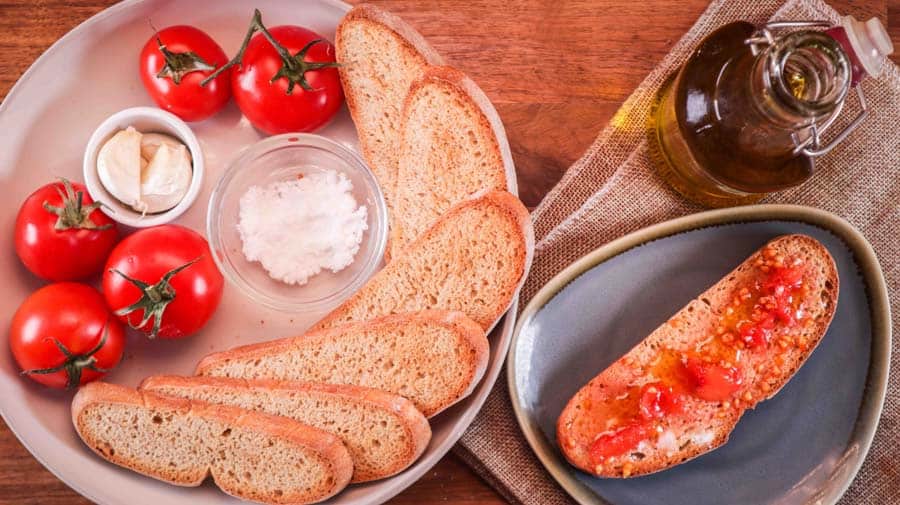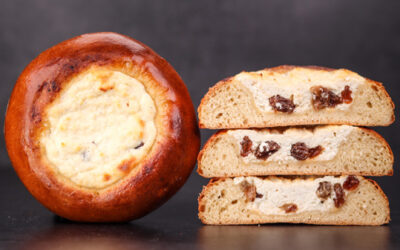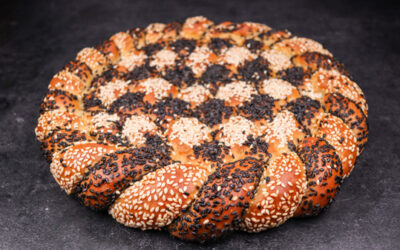Pa amb tomaquet simply translates to tomato bread. Its beauty is its simplicity. But as with anything, the simpler it is the better the ingredients must be.
It is made by toasting thinly sliced bread until it is crispy on both sides, then a garlic clove is rubbed on the surface followed by a ripe tomato. Lastly, a good drizzle of olive oil and a sprinkle of sea salt. An awesome sharing snack as you can place all the ingredients on a large plate or platter in the middle of a table and have your guests make their own one by one.
This is a Catalonian snack in fact, but Andorra is right there, and it is just as popular there as in Catalan.
The bread we will make is like a ciabatta. I chose it because the preferment will give it a nice sour flavour and a substantial crust and crumb able to withstand the rubbing of garlic and tomato. The second reason for using a ciabatta shaped loaf is that it can be sliced into evenly sized slices without leaving tiny end bits.
Speaking of toppings, you must use the best ingredients you can get. There are only a few and that is why it is important for them to be tasty. I got some fresh vine tomatoes from my local market. A good extra virgin olive oil and quality sea salt.
Normally people would just buy the bread and assemble the sandwich, but since this is a bread channel, we are making our own and that always makes it taste better.
Plus, you can use the recipe to make little ciabattas if you like and skip the pa amb tomaquet part.
Watch the video down below for detailed instructions.
Ingredients
For the preferment (biga) –
50g (1.75oz) wholemeal flour
Tiny pinch of yeast
40g (1.4oz) water, at room temperature if your kitchen is around 22-24C (72-75F). If it is warmer, then use cooler water *
*To learn more about dough temperature control click here.
For the main dough –
200g (7oz) strong white bread flour
3g (0.1oz) instant dry yeast or 3.6g (0.12oz) active dry yeast or 9g (0.3oz) fresh yeast
5g (0.17oz) salt
15g (0.5oz) olive oil
110g (3.5oz) cold water *
*To learn more about dough temperature when using a preferment click here.
For the toppings –
Ripe tomatoes, halved
Unpeeled garlic cloves, halved
Extra virgin olive oil
Sea salt
Method
- Make the preferment. In a small bowl combine the water, yeast, and wholemeal flour. Mix until there is no dry flour left. Cover and ferment for 10 – 12 hours. *If you are not ready to make the final dough by the time your preferment is ready, then simply pop it in the fridge to slow down fermentation and get back to it when you are ready to make the dough.
- In a large bowl combine the water, yeast, salt, and oil. Mix well to dissolve any large salt crystals and to hydrate the yeast. Add the preferment and the white flour. Mix everything together using your scraper. *If your kitchen is particularly warm like mine was, then you can refrigerate the preferment to stop your dough from getting too warm.
- Tip the dough out on your table and knead it for around 5 minutes. *Desired dough temperature 25C (77F). If your dough is warmer, then it will ferment more rapidly. If it is cooler, then it will take longer. Adjust proofing time accordingly.
- Cover and ferment for 1 hour.
- Fold.
- Ferment for 1 more hour.
- Flatten the dough and trim the edges using your scraper. Place the trimmings on a non-stick paper lined tray and place the larger piece of dough on top.
- Final proof 5 hours. *During the final hour of fermentation preheat your oven to 230C (450F) fan off.
- Scoring is optional on this one. Bake it for around 20 minutes.
- Leave the loaf to cool down completely. At least one hour.
- Slice it thinly, lay it out on a tray and toast it in the oven turning it over half-way. Both sides should be nicely browned, and the bread should be dry and crispy.
- Serve immediately as it is best while it is warm. Make sure all other elements are ready by the time the bread is.
Enjoy! And check out more of the Baking World Tour.
Keep in mind that the conditions in each kitchen are different, so fermentation times may vary for you. It is up to the baker to control the bread and react accordingly.
Your oven may be different too, so your baking time may vary.
Watch the video here



